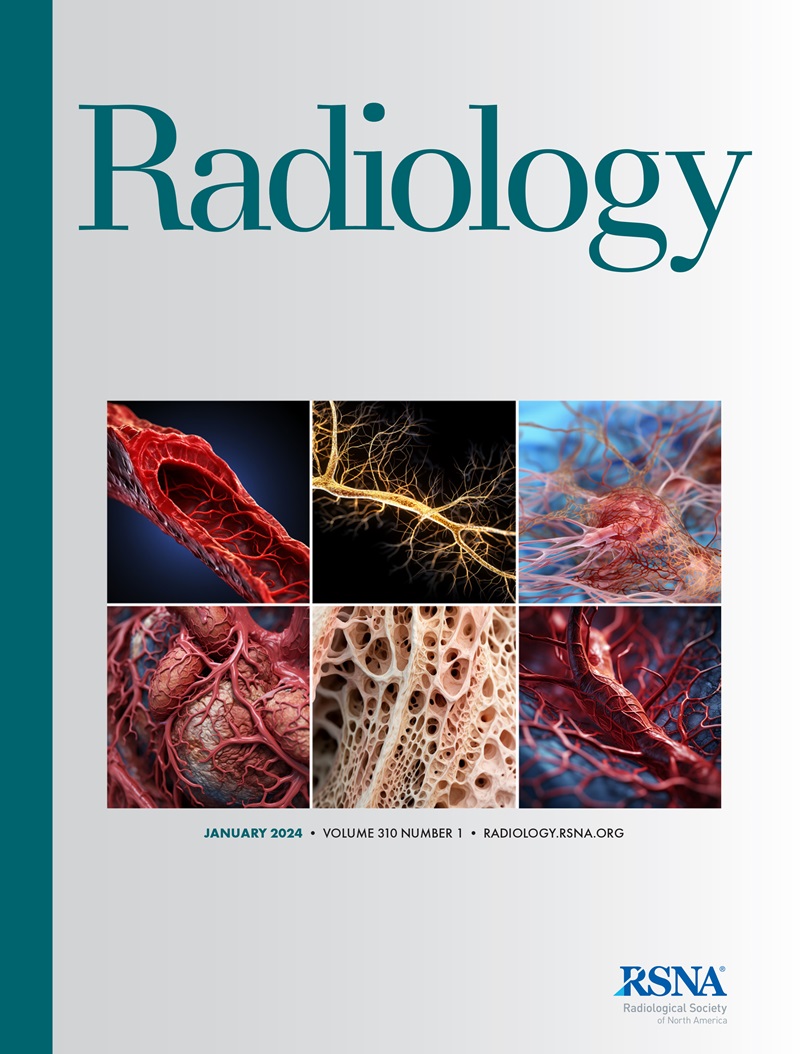Anton R Banta, Raimondo D'Ambrosio, Christof Karmonik, Sunil Mathur, Eugene V Golanov, Angelique Regnier-Golanov, Behnaam Aazhang, Gavin W Britz
求助PDF
{"title":"用相衬MRI定量测定人脑脊液沿大动脉的血管周围流动动力学。","authors":"Anton R Banta, Raimondo D'Ambrosio, Christof Karmonik, Sunil Mathur, Eugene V Golanov, Angelique Regnier-Golanov, Behnaam Aazhang, Gavin W Britz","doi":"10.1148/radiol.243521","DOIUrl":null,"url":null,"abstract":"<p><p>Background Dysfunction in cerebrospinal fluid (CSF) flow dynamics is linked to several neurologic disorders. Although phase-contrast MRI has been used to measure them in the brain, studies in the perivascular space are lacking. Purpose To develop a pipeline of image processing algorithms using contrast-unenhanced 7-T phase-contrast MRI to locate and quantify human brain CSF dynamics along the perivascular space of major arteries and their branches. Materials and Methods In this prospective, single-center study, data were collected from healthy participants, enrolled consecutively, who underwent contrast-unenhanced 7-T phase-contrast MRI at the Houston Methodist Research Institute between February 2020 and July 2023. Data preprocessing included skull removal and contrast enhancement. Vessel detection was achieved by using a chained hysteresis algorithm with two tunable parameters: a high threshold for identifying vessel pixels and a low threshold for image noise cutoff. Perivascular space was detected using a dilation algorithm. CSF velocity was measured in the cerebral aqueduct and three manually segmented perivascular regions: region 1 (internal carotid artery and M1 branch of middle cerebral artery [MCA]), region 2 (M2 segment of MCA), and region 3 (distal cortical branches of MCA or M3 segment). Linear mixed-effects models were calculated between CSF velocity curves in the aqueduct and perivascular spaces to assess their relationship. Two-tailed Mann-Whitney <i>U</i> and <i>F</i> tests were used to assess differences in CSF velocity across two age groups (age 20-39 years and 40-59 years). Results A total of 28 participants (mean age, 40 years ± 11 [SD]; 14 male and 14 female participants) were included. A linear mixed-effects model showed a positive association between aqueduct and perivascular CSF velocity in three regions along the MCA (0.013 cm/sec [<i>P</i> < .001], 0.024 cm/sec [<i>P</i> < .001], and 0.010 cm/sec [<i>P</i> < .001]). Additionally, the height (0.06 vs 0.16 cm/sec; <i>P</i> = .002) and SD (0.02 vs 0.05 cm/sec; <i>P</i> < .001) of the perivascular CSF velocity curve in the distal cortical branches of the MCA differed between the two age groups. Conclusion A semiautomated pipeline of algorithms using phase-contrast MRI was developed to locate and quantify age-dependent human CSF dynamics along the perivascular spaces of major brain arteries. © RSNA, 2025 <i>Supplemental material is available for this article.</i></p>","PeriodicalId":20896,"journal":{"name":"Radiology","volume":"316 3","pages":"e243521"},"PeriodicalIF":15.2000,"publicationDate":"2025-09-01","publicationTypes":"Journal Article","fieldsOfStudy":null,"isOpenAccess":false,"openAccessPdf":"","citationCount":"0","resultStr":"{\"title\":\"Quantification of Perivascular Flow Dynamics of Human Cerebrospinal Fluid Along Major Arteries Using Phase-Contrast MRI.\",\"authors\":\"Anton R Banta, Raimondo D'Ambrosio, Christof Karmonik, Sunil Mathur, Eugene V Golanov, Angelique Regnier-Golanov, Behnaam Aazhang, Gavin W Britz\",\"doi\":\"10.1148/radiol.243521\",\"DOIUrl\":null,\"url\":null,\"abstract\":\"<p><p>Background Dysfunction in cerebrospinal fluid (CSF) flow dynamics is linked to several neurologic disorders. Although phase-contrast MRI has been used to measure them in the brain, studies in the perivascular space are lacking. Purpose To develop a pipeline of image processing algorithms using contrast-unenhanced 7-T phase-contrast MRI to locate and quantify human brain CSF dynamics along the perivascular space of major arteries and their branches. Materials and Methods In this prospective, single-center study, data were collected from healthy participants, enrolled consecutively, who underwent contrast-unenhanced 7-T phase-contrast MRI at the Houston Methodist Research Institute between February 2020 and July 2023. Data preprocessing included skull removal and contrast enhancement. Vessel detection was achieved by using a chained hysteresis algorithm with two tunable parameters: a high threshold for identifying vessel pixels and a low threshold for image noise cutoff. Perivascular space was detected using a dilation algorithm. CSF velocity was measured in the cerebral aqueduct and three manually segmented perivascular regions: region 1 (internal carotid artery and M1 branch of middle cerebral artery [MCA]), region 2 (M2 segment of MCA), and region 3 (distal cortical branches of MCA or M3 segment). Linear mixed-effects models were calculated between CSF velocity curves in the aqueduct and perivascular spaces to assess their relationship. Two-tailed Mann-Whitney <i>U</i> and <i>F</i> tests were used to assess differences in CSF velocity across two age groups (age 20-39 years and 40-59 years). Results A total of 28 participants (mean age, 40 years ± 11 [SD]; 14 male and 14 female participants) were included. A linear mixed-effects model showed a positive association between aqueduct and perivascular CSF velocity in three regions along the MCA (0.013 cm/sec [<i>P</i> < .001], 0.024 cm/sec [<i>P</i> < .001], and 0.010 cm/sec [<i>P</i> < .001]). Additionally, the height (0.06 vs 0.16 cm/sec; <i>P</i> = .002) and SD (0.02 vs 0.05 cm/sec; <i>P</i> < .001) of the perivascular CSF velocity curve in the distal cortical branches of the MCA differed between the two age groups. Conclusion A semiautomated pipeline of algorithms using phase-contrast MRI was developed to locate and quantify age-dependent human CSF dynamics along the perivascular spaces of major brain arteries. © RSNA, 2025 <i>Supplemental material is available for this article.</i></p>\",\"PeriodicalId\":20896,\"journal\":{\"name\":\"Radiology\",\"volume\":\"316 3\",\"pages\":\"e243521\"},\"PeriodicalIF\":15.2000,\"publicationDate\":\"2025-09-01\",\"publicationTypes\":\"Journal Article\",\"fieldsOfStudy\":null,\"isOpenAccess\":false,\"openAccessPdf\":\"\",\"citationCount\":\"0\",\"resultStr\":null,\"platform\":\"Semanticscholar\",\"paperid\":null,\"PeriodicalName\":\"Radiology\",\"FirstCategoryId\":\"3\",\"ListUrlMain\":\"https://doi.org/10.1148/radiol.243521\",\"RegionNum\":1,\"RegionCategory\":\"医学\",\"ArticlePicture\":[],\"TitleCN\":null,\"AbstractTextCN\":null,\"PMCID\":null,\"EPubDate\":\"\",\"PubModel\":\"\",\"JCR\":\"Q1\",\"JCRName\":\"RADIOLOGY, NUCLEAR MEDICINE & MEDICAL IMAGING\",\"Score\":null,\"Total\":0}","platform":"Semanticscholar","paperid":null,"PeriodicalName":"Radiology","FirstCategoryId":"3","ListUrlMain":"https://doi.org/10.1148/radiol.243521","RegionNum":1,"RegionCategory":"医学","ArticlePicture":[],"TitleCN":null,"AbstractTextCN":null,"PMCID":null,"EPubDate":"","PubModel":"","JCR":"Q1","JCRName":"RADIOLOGY, NUCLEAR MEDICINE & MEDICAL IMAGING","Score":null,"Total":0}
引用次数: 0
引用
批量引用

 求助内容:
求助内容: 应助结果提醒方式:
应助结果提醒方式:


